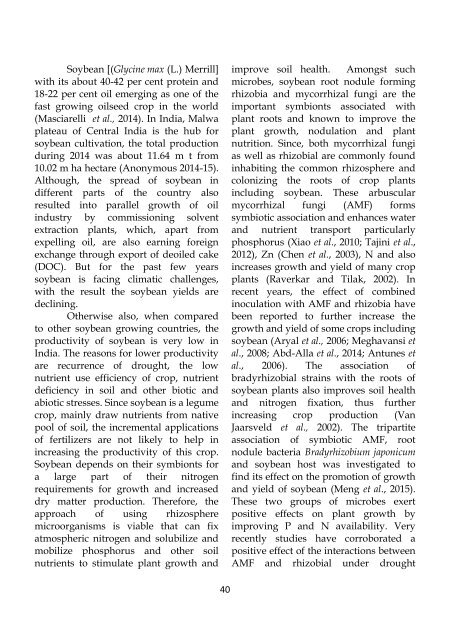SOYBEAN RESEARCH
Soybean-Research-14(2)-2016
Soybean-Research-14(2)-2016
Create successful ePaper yourself
Turn your PDF publications into a flip-book with our unique Google optimized e-Paper software.
Soybean [(Glycine max (L.) Merrill]<br />
with its about 40-42 per cent protein and<br />
18-22 per cent oil emerging as one of the<br />
fast growing oilseed crop in the world<br />
(Masciarelli et al., 2014). In India, Malwa<br />
plateau of Central India is the hub for<br />
soybean cultivation, the total production<br />
during 2014 was about 11.64 m t from<br />
10.02 m ha hectare (Anonymous 2014-15).<br />
Although, the spread of soybean in<br />
different parts of the country also<br />
resulted into parallel growth of oil<br />
industry by commissioning solvent<br />
extraction plants, which, apart from<br />
expelling oil, are also earning foreign<br />
exchange through export of deoiled cake<br />
(DOC). But for the past few years<br />
soybean is facing climatic challenges,<br />
with the result the soybean yields are<br />
declining.<br />
Otherwise also, when compared<br />
to other soybean growing countries, the<br />
productivity of soybean is very low in<br />
India. The reasons for lower productivity<br />
are recurrence of drought, the low<br />
nutrient use efficiency of crop, nutrient<br />
deficiency in soil and other biotic and<br />
abiotic stresses. Since soybean is a legume<br />
crop, mainly draw nutrients from native<br />
pool of soil, the incremental applications<br />
of fertilizers are not likely to help in<br />
increasing the productivity of this crop.<br />
Soybean depends on their symbionts for<br />
a large part of their nitrogen<br />
requirements for growth and increased<br />
dry matter production. Therefore, the<br />
approach of using rhizosphere<br />
microorganisms is viable that can fix<br />
atmospheric nitrogen and solubilize and<br />
mobilize phosphorus and other soil<br />
nutrients to stimulate plant growth and<br />
improve soil health. Amongst such<br />
microbes, soybean root nodule forming<br />
rhizobia and mycorrhizal fungi are the<br />
important symbionts associated with<br />
plant roots and known to improve the<br />
plant growth, nodulation and plant<br />
nutrition. Since, both mycorrhizal fungi<br />
as well as rhizobial are commonly found<br />
inhabiting the common rhizosphere and<br />
colonizing the roots of crop plants<br />
including soybean. These arbuscular<br />
mycorrhizal fungi (AMF) forms<br />
symbiotic association and enhances water<br />
and nutrient transport particularly<br />
phosphorus (Xiao et al., 2010; Tajini et al.,<br />
2012), Zn (Chen et al., 2003), N and also<br />
increases growth and yield of many crop<br />
plants (Raverkar and Tilak, 2002). In<br />
recent years, the effect of combined<br />
inoculation with AMF and rhizobia have<br />
been reported to further increase the<br />
growth and yield of some crops including<br />
soybean (Aryal et al., 2006; Meghavansi et<br />
al., 2008; Abd-Alla et al., 2014; Antunes et<br />
al., 2006). The association of<br />
bradyrhizobial strains with the roots of<br />
soybean plants also improves soil health<br />
and nitrogen fixation, thus further<br />
increasing crop production (Van<br />
Jaarsveld et al., 2002). The tripartite<br />
association of symbiotic AMF, root<br />
nodule bacteria Bradyrhizobium japonicum<br />
and soybean host was investigated to<br />
find its effect on the promotion of growth<br />
and yield of soybean (Meng et al., 2015).<br />
These two groups of microbes exert<br />
positive effects on plant growth by<br />
improving P and N availability. Very<br />
recently studies have corroborated a<br />
positive effect of the interactions between<br />
AMF and rhizobial under drought<br />
40


